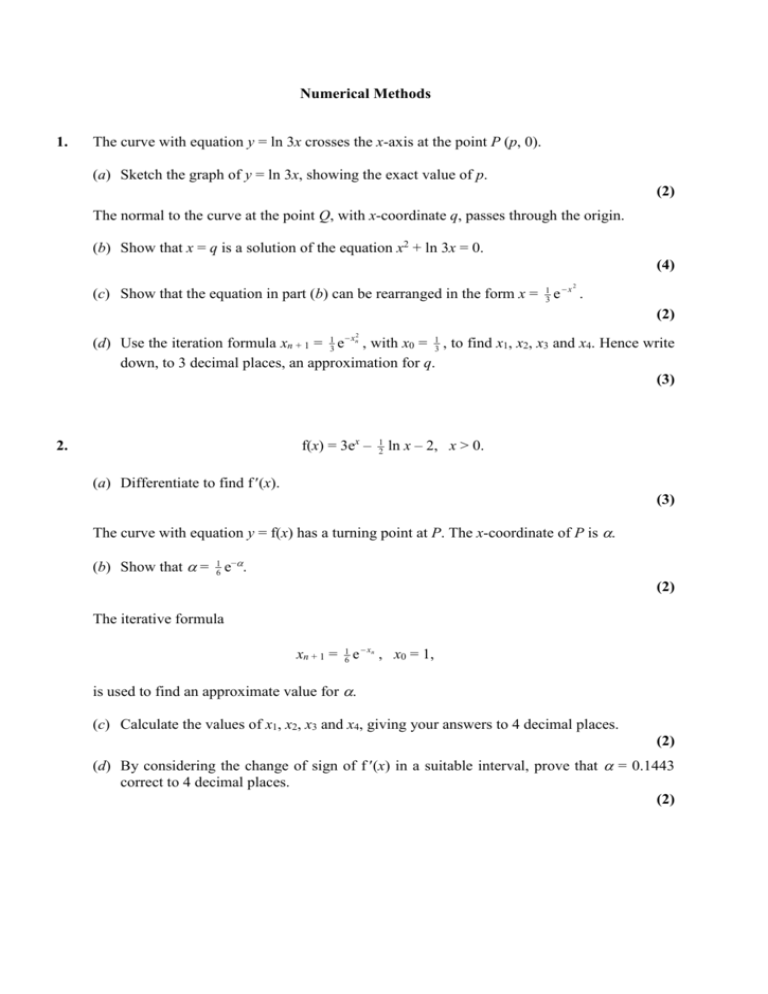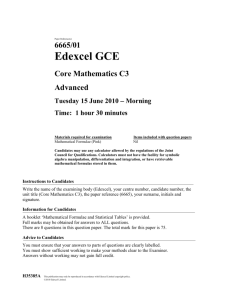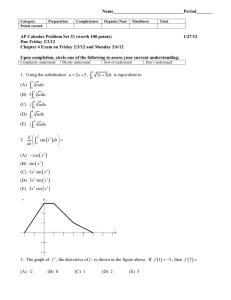Numerical Methods Answers
advertisement

Numerical Methods
1.
The curve with equation y = ln 3x crosses the x-axis at the point P (p, 0).
(a) Sketch the graph of y = ln 3x, showing the exact value of p.
(2)
The normal to the curve at the point Q, with x-coordinate q, passes through the origin.
(b) Show that x = q is a solution of the equation x2 + ln 3x = 0.
(4)
(c) Show that the equation in part (b) can be rearranged in the form x = 13 e x .
2
(2)
(d) Use the iteration formula xn + 1 = 13 e xn , with x0 = 13 , to find x1, x2, x3 and x4. Hence write
down, to 3 decimal places, an approximation for q.
(3)
2
f(x) = 3ex –
2.
1
2
ln x – 2, x > 0.
(a) Differentiate to find f (x).
(3)
The curve with equation y = f(x) has a turning point at P. The x-coordinate of P is .
(b) Show that =
1
6
e–.
(2)
The iterative formula
xn + 1 = 16 e xn , x0 = 1,
is used to find an approximate value for .
(c) Calculate the values of x1, x2, x3 and x4, giving your answers to 4 decimal places.
(2)
(d) By considering the change of sign of f (x) in a suitable interval, prove that = 0.1443
correct to 4 decimal places.
(2)
f(x) = 2x3 – x – 4.
3.
(a) Show that the equation f(x) = 0 can be written as
x=
2 1
.
x 2
(3)
The equation 2x3 – x – 4 = 0 has a root between 1.35 and 1.4.
(b) Use the iteration formula
xn + 1 =
2 1
,
xn 2
with x0 = 1.35, to find, to 2 decimal places, the value of x1, x2 and x3.
(3)
The only real root of f(x) = 0 is .
(c) By choosing a suitable interval, prove that = 1.392, to 3 decimal places.
(3)
4.
Figure 2
O
O
4
x
P
Figure 2 shows part of the curve with equation
y = (2x – 1) tan 2x,
0x<
.
4
The curve has a minimum at the point P. The x-coordinate of P is k.
(a) Show that k satisfies the equation
4k + sin 4k – 2 = 0.
(6)
The iterative formula
xn + 1 =
1
4
(2 – sin 4xn), x0 = 0.3,
is used to find an approximate value for k.
(b) Calculate the values of x1, x2, x3 and x4, giving your answers to 4 decimals places.
(3)
(c) Show that k = 0.277, correct to 3 significant figures.
(2)
Numerical Methods Answers
Question
number
1.
(a)
Scheme
Marks
y
Shape B1
p=
1
3
or { 13 , 0} seen B1
(2)
1
3
O
(b) Gradient of tangent at Q =
1
q
B1
Gradient of normal = q
M1
Attempt at equation of OQ [y = qx] and substituting x = q, y = ln 3q
or attempt at equation of tangent [y – 3 ln q = q(x – q)] with x = 0, y = 0
or equating gradient of normal to (ln 3q)/q
M1
q2 + ln 3q = 0 (*)
A1
(4)
M1; A1
(2)
(c) ln 3x = x2 3x = e x ; x = 13 e x
2
2
(d) x1 = 0.298280; x2 = 0.304957, x3 = 0.303731, x4 = 0.303958
Root = 0.304 (3 decimal places)
M1; A1
A1
(3)
(11 marks)
2
(a)
f (x) = 3 ex –
3e x
M1A1A1
1
2x
(3)
M1
1
=0
2x
6 e 1
1
e
(*)
A1 cso
6
(c)
x1 0.0613..., x2 0.1568.., x3 0.1425..., x4 0.1445....
M1 A1
[M1 at least x1 correct , A1 all correct to 4 d.p.]
(d)
1
with suitable interval
2x
e.g. f (0.14425) = – 0.0007
Using f (x) = 3 ex –
M1
(2)
(2)
f (0.14435) = + 0.002(1)
Accuracy (change of sign and correct values)
A1
(2)
[9]
3.
2 x2 1
(a)
4
0
x
Dividing
M1
equation by x
x2
1 4
2 2x
M1
Obtaining x …
2
x
2 1
x 2
cso
x1 1.41, x2 1.39, x3 1.39
(b)
If answers given to more than 2 dp, penalise first time then accept awrt
above.
(c)
cso
B1, B1,
B1
(3)
Choosing 1.3915,1.3925 or a tighter interval
M1
f 1.3915 3103 , f 1.3925 7 103
A1
Both, awrt
Change of sign (and continuity)
A1
(3)
1.3915,1.3925
1.392 to 3 decimal places
A1
(3)
[9]
4.
(a)
Using product rule:
dy
2 tan 2 x 2(2 x 1) sec 2 2 x
dx
sin 2 x
1
" and “ sec 2 x
"
cos 2 x
cos 2 x
sin 2 x
1
2(2 x 1)
[ 2
]
cos 2 x
cos 2 2 x
dy
Setting
= 0 and multiplying through to eliminate fractions
dx
[ 2 sin 2 x cos 2 x 2(2 x 1) = 0]
M1 A1 A1
Use of “tan 2x =
M1
M1
Completion: producing 4k sin 4k 2 0 with no wrong
A1*
(6)
working seen and at least previous line seen. AG
(b)
x1 0.2670, x2 0.2809, x3 0.2746, x4 0.2774,
Note: M1 for first correct application, first A1 for two correct,
second A1 for all four correct
Max –1 deduction, if ALL correct to > 4 d.p. M1 A0 A1
SC: degree mode: M1 x1 0.4948 , A1 for x2 = 0 .4914, then
A0; max 2
(c) Choose suitable interval for k: e.g. [0.2765, 0.2775] and evaluate
f(x) at these values
Show that 4k sin 4k 2 changes sign and deduction
M1 A1 A1 (3)
M1
A1
(2)
[f(0.2765) = –0.000087.., f(0.2775) = +0.0057]
Note:
Continued iteration: (no marks in degree mode)
Some evidence of further iterations leading to 0.2765 or better
M1;
Deduction A1
(11 marks)








